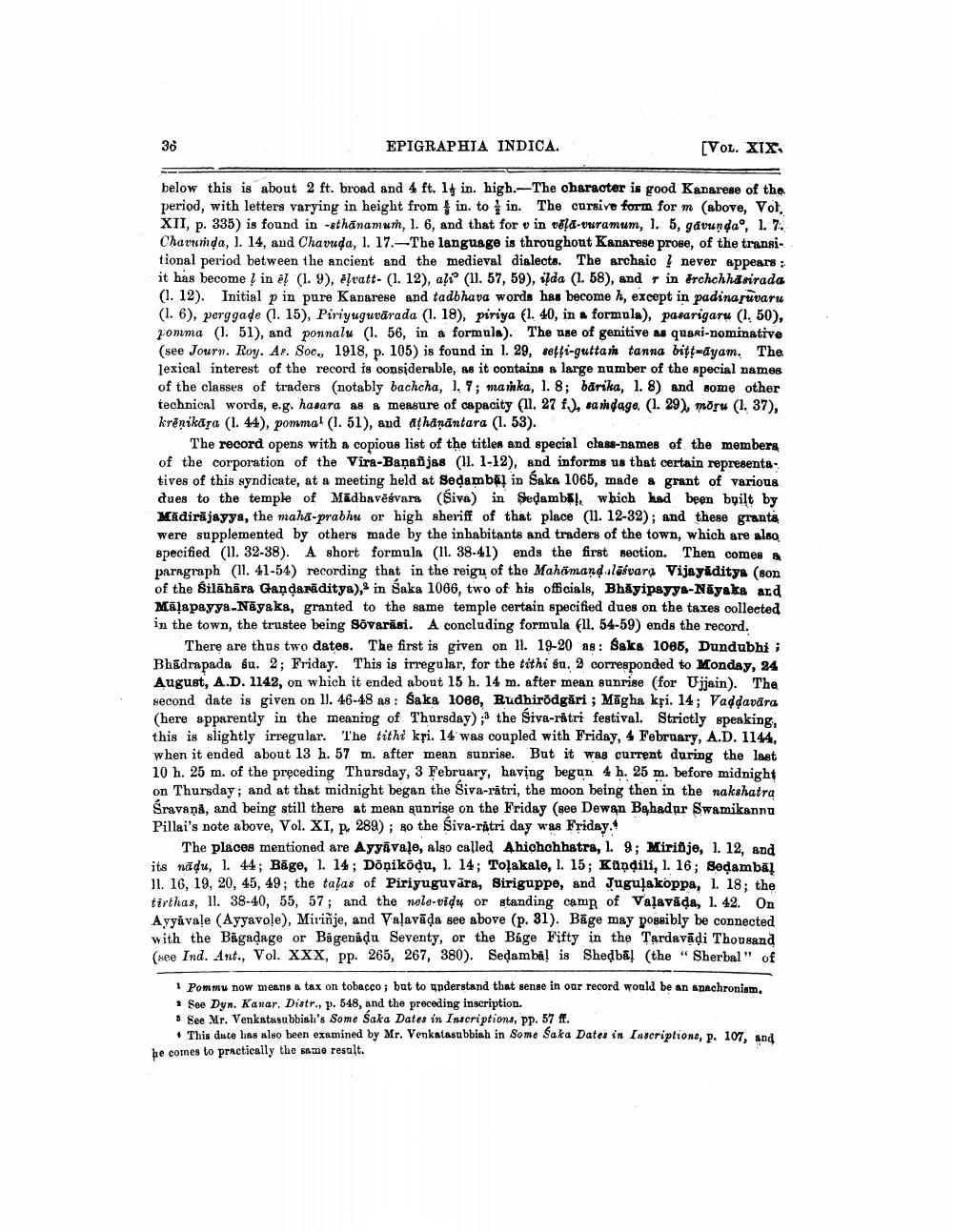________________
EPIGRAPHIA INDICA.
[VOL. XIX
below this is about 2 ft. broad and 4 ft. 14 in. high. The character is good Kanarese of the period, with letters varying in height from in. to in. The cursive form for m (above, Vol. XII, p. 335) is found in -ethanamur, 1. 6, and that for v in veļa-vuramum, 1. 5, gavunda', 1. 74 Chavumda, 1. 14, and Chavuda, 1. 17.-The language is throughout Kanarese prose, of the transitional period between the ancient and the medieval dialects. The archaic ? never appears : it has become ! in e! (1. 9), éļvatt- (1. 12), aļi" (1). 57, 59), ida (1. 58), and r in erchchha sirada (1. 12). Initial p in pure Kanarese and tadbhava words has become h, except in padinaruvaru (1. 6), perggade (1. 15), Piriyuguvārada (1. 18), piriya (1. 40, in a formula), pasarigaru (1. 50), romma (1. 51), and ponnalu (1. 56, in a formula). The use of genitive as quasi-nominative (see Journ. Roy. As. Soc., 1918, p. 105) is found in l. 29, setti-guttan tanna bitt=āyam. The lexical interest of the record is considerable, es it contains a large number of the special names of the classes of traders (notably bachcha, 1,9; mamka, 1. 8; bärika, 1. 8) and some other technical words, e.g. hasara as a measure of capacity (11. 27 f.), sandage (1. 29), mõru (1. 37), krēnikāra (1. 44), pomma' (1. 51), and athânāntara (1. 53).
The record opens with a copious list of the titles and special class-names of the members of the corporation of the Vira-Baņañjas (11. 1-12), and informs us that certain representa tives of this syndicate, at a meeting held at Sedambal in Sake 1065, made a grant of various dues to the temple of Mādbavēśvara (Siva) in Sedambal, which had been bọilt by Mădirajayya, the maha-prabhu or high sheriff of that place (11. 12-32); and these grants were supplemented by others made by the inhabitants and traders of the town, which are also specified (11. 32-38). A short formula (Il. 38-41) ends the first section. Then comes a paragraph (11. 41-54) recording that in the reign of the Mahāmandılāšvarą Vijayiditya (son of the Silähāra Gandarāditya), in Saka 1066, two of his officials, Bhāyipayya-Nāyaks and Māļapayya-NĒyaka, granted to the same temple certain specified dues on the taxes collected in the town, the trustee being Sõvarāsi. A concluding formula fll. 54-59) ends the record.
There are thus two dates. The first is given on 11. 19-20 as: Saka 1085, Dundubhi ; Bhadrapada su. 2; Friday. This is irregular, for the tithi su, 2 corresponded to Monday, 24 August, A.D. 1142, on which it ended about 15 h. 14 m. after mean sunrise (for Ujjain). The second date is given on II. 46-48 as : Saka 1066, Budhirõdgări ; Māgha kri. 14; Vaddavära (here apparently in the meaning of Thursday); the Siva-rätri festival. Strictly speaking, this is slightly irregular. The tithi kri. 14 was coupled with Friday, 4 February, A.D. 1144. when it ended about 13 h. 57 m. after mean sunrise. But it was current during the last 10 h. 25 m. of the preceding Thursday, 3 February, having begun 4 h. 25 m. before midnight on Thursday; and at that midnight began the Siva-rätri, the moon being then in the nakshatra Śravana, and being still there at mean gunrise on the Friday (see Dewan Bahadur Swamikannu Pillai's note above, Vol. XI, p. 289); 8o the Siva-råtri day was Friday.!
The places mentioned are Ayyavale, also called Ahichchhatra, l. 9; Miriñje, 1. 12, and its nādu, 1. 44; Bāge, 1. 14; Dāņikodu, 1. 14; Tolakale, 1. 15; Kūņdili, 1. 16; Sedambēļ Jl. 16, 19, 20, 45, 49; the talas of Piriyuguvāra, Siriguppe, and Jugulakoppa, 1. 18; the tirthas, 11. 38-40, 55, 57; and the nele-vidu or standing camp of Vaļavāda, 1. 42. On Ayyavale (Ayyavole), Miriñje, and Valavāda see above (p. 31). Bāge may possibly be connected with the Bågadage or Bägenādu Seventy, or the Báge Fifty in the Tardavādi Thousand (nee Ind. Ant., Vol. XXX, pp. 265, 267, 380). Sedamba! is Shedba! (the "Sherbal" of
1 Pommu now means a tax on tobacco; but to understand that sense in our record would be an anachronism,
See Dyn. Kanar. Distr., p. 548, and the preceding inscription. * See Mr. Venkatasubbiah's Some Saka Dates in Inscriptions, pp. 57 ff.
This dute has also been examined by Mr. Venkatasubbiah in Some Saka Dates in Inscriptione, P. 107, and be comes to practically the same result.




